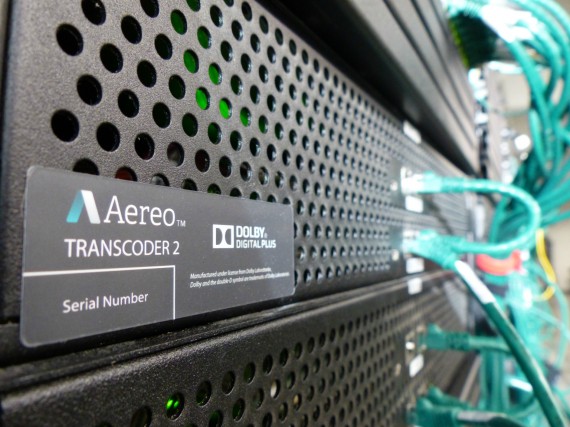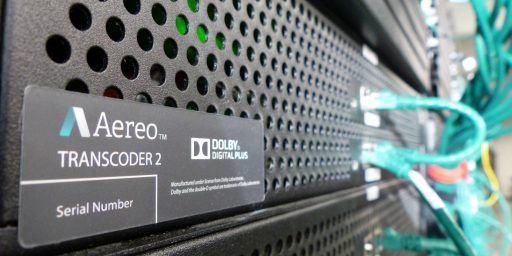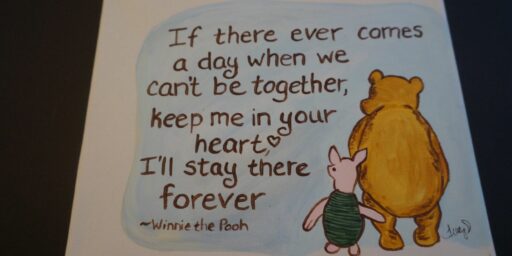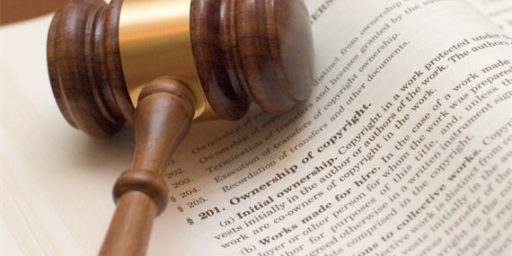Aereo Loses Big As Supreme Court Upholds Intellectual Property Protections
New technology doesn't mean that the laws don't apply.
In the second of two rulings in high profile cases today, the first being the cell phones case I wrote about earlier, the Supreme Court sided with television broadcasters in their lawsuit against Aereo, a company whose business model consists of intercepting over-the-air broadcasts and transmitting them to subscribers over the Internet:
WASHINGTON — In a decision with far-reaching implications for the television industry, the Supreme Court ruled on Wednesday that Aereo, a start-up streaming service, had violated copyright laws by capturing broadcast signals on miniature antennas and delivering them to subscribers for a fee.
The 6-3 decision was a victory for the major television networks, which had argued that Aereo’s business model amounted to a theft of their programming. The judges’ ruling leaves the current broadcast model intact while imperiling Aereo’s viability as a business after just over two years in existence.
The Supreme Court case comes at a crucial time in the media industry, when entertainment companies are navigating vast technological changes and rapid shifts in viewer habits. As a result, the economics of television financing and distribution are changing.
In arguments before the court in April, the broadcasters contended that Aereo and similar services threatened to cut into a vital revenue stream — the billions of dollars they receive from cable and satellite companies in retransmission fees, the money paid to networks and local stations for the right to retransmit their programming. The networks said this revenue was so essential that they would have considered removing their signals from the airwaves had the court ruled for Aereo.
The start-up contended that the service it provided through warehouses of small antennas was merely helping its subscribers do what they could lawfully do since the era of rabbit-ears: watch free broadcast television delivered over public airwaves.
Justice Stephen G. Breyer, writing for the majority, rejected all of Aereo’s major arguments. He said the service was “not simply an equipment provider” but acted like a cable system in that it transmitted copyrighted content. “Insofar as there are difference,” he wrote, “those differences concern not the nature of the service that Aereo provides so much as the technological manner in which it provides the service.”
Nor did Justice Breyer accept Aereo’s argument that its transmissions were private performances because they were made one at a time. “You can transmit a message to your friends whether you send identical emails to each friend or a single email all at once,” he said in announcing the decision from the bench.
(…)
In a dissent that expressed distaste for Aereo’s business model, Justice Antonin Scalia said the service had identified a loophole in the law. “It is not the role of this court to identify and plug loopholes,” he wrote.
Justices Clarence Thomas and Samuel A. Alito Jr. joined the dissent.
Broadcasters applauded Wednesday’s decision, and shares in the media groups shot up in the morning. CBS experienced the most dramatic increase of the media companies, with shares up about 4.5 percent in early trading.
“We’re gratified the Court upheld important Copyright principles that help ensure that the high-quality creative content consumers expect and demand is protected and incentivized,” The Walt Disney Company, which owns ABC, said in a statement.
Paul Clement, a lawyer for the petitioners in the case, characterized the decision as a “victory for consumers” and said the court “has sent a clear message that it will uphold the letter and spirit of the law just as Congress intended.”
Chet Kanojia, Aereo’s founder and chief executive, said in a statement that the ruling was a “massive setback” for consumers and “sends a chilling message to the technology industry.”
Mr. Kanojia said that Aereo had worked to create a technology that complied with the law. “Today’s decision clearly states that how the technology works does not matter,” he said.
Mr Kanojia pledged that the start-up would carry on with its battle, though he did not offer specifics on how Aereo would proceed.
As I stated when I wrote about the oral argument in this case, it seems clear to me that Aereo’s business model, while certainly innovative, was clearly built on copyright infringement. Indeed, although the technology is different there’s little significant difference between what Aereo does and what Napster did when it was first introduced in the late 1990s. Both technologies involve the appropriation of the copyrighted material of others without their consent and without the payment of any compensation. Napster’s business model was ultimately, and correctly, found to violate a number of provisions of the copyright laws and the service ended up essentially shutting down, although it did make an effort to rebrand itself as a paid service that acted in compliance with the law. The only functional difference between Napster and Aereo is the fact that Aereo was charging people for accessing the copyrighted material while Napster was essentially free, but that only seems to make Aereo a more egregious theft of intellectual property. While the legal issues in the two cases are different, the concsept is basically the same, and it is not at all surprising that the case turned out this way.
The Wall Street Journal notes that the decision poses a big problem for Aereo’s business going forward, and that seems to be fairly clear. While the case has been remanded to the lower court for further proceedings, meaning that Aereo can likely continue operating for now, the writing is on the wall. Eventually, absent consent from the copyright owners or a set of licensing agreements from the broadcast networks as well as all the other entities that have intellectual property interests in the material they broadcast, Aereo will have to close its doors. Consent, of course, is unlikely without compensation, and one would imagine that the licensing agreements would prove to be so expensive that Aereo would lose the pricing advantage that it has over cable networks, which is its main reason for existing. Matt Connolly argues that the ruling is one “against the future of television,” arguing that the Court’s decision is likely to have an impact far beyond Aereo on other technologies that are leading to new ways for people to view entertainment. It strikes me, though, that this is only true if you think that the future of television is dependent upon stealing content from the people who create it, and that is a business model that is ultimately self destructive. The more likely outcome is that this will mean that this future of television, or whatever we might end up calling it in the coming decades, will happen, but it will happen in a manner that respects the law. Congress could step in and change the law to make these new technologies legal, of course, but that seems unlikely and I’m not sure that it would be wise policy.
Lyle Denniston, meanwhile, notes that while the Court did hand Aereo an across the board defeat, it was careful to say that it was not ruling on future technology:
Insisting that it was not striking a blow against new communications technology, the Supreme Court on Wednesday nevertheless took a sizeable step toward shutting down at least part of a fresh approach to delivering TV programs to paying audiences. It ruled that the engineers at the new firm of Aereo, Inc. had — so far — not found a way to avoid violating television networks’ copyright privileges by delivering their programs to Aereo’s customers for a small monthly fee.
The analytical technique the Court used in finding a likely copyright violation by Aereo was to compare its streaming of Internet-based TV programs to cable TV systems’ snatching of TV broadcasts out of the airwaves for re-delivery to customers. Congress meant to bar that kind of programming in a major 1976 revision of the Copyright Act, the Court said, and it applied that change directly to Aereo’s clever new business model.
The over-the-air TV broadcast industry had taken the case of American Broadcasting Companies v. Aereo to the Supreme Court, claiming that its very survival was at stake. Aereo’s system, the industry contended, was offering a very cheap version of TV programming to its customers while paying not a cent in royalties to the TV networks and their program developers. This was threatening to draw the networks’ own paying customers away, depriving it of revenues that have been replacing their declining take from advertising, the TV firms said.
The Court, in its six-to-three ruling, said nothing about rescuing the TV broadcasters, basing its ruling on a fairly simple application of what it means to “perform” a copyrighted program through distribution to “the public.” Aereo’s system, Justice Stephen G. Breyer wrote for the majority, both performs the copyrighted programs and does so through delivery to the public.
Aereo has developed a system in which it uses thousands of tiny antennas, each tuned to respond to an individual customer’s Internet demand for a particular TV program, and through those antennas it delivers to each customer only their own personal copy. Aereo contended that it simply was supplying the technology hardware — like a DVD recorder — to enable its customers to get access to TV programs that were broadcast over the air.
The Court rejected that claim, concluding that Aereo was not simply an equipment provider. It was putting on the TV shows for its customers, the public.
However, the Court went to some lengths to show that it was issuing only a narrow ruling. It said it was dealing, at this point, only with Aereo’s system so far as it enabled its viewers to view copyrighted TV programs “live,” or after only a brief delay. Justice Breyer stressed that the decision said nothing about downloading a TV program in order to recover it and keep it on hand for somewhat later viewing.
As the case had unfolded before the Court, many in the communications technology sector had worried that a ruling against Aereo would lead to new copyright restrictions on the modern phenomenon of “cloud computing” — that is, downloading something from the Internet, and storing it in a “cloud” provided as a separate service.
It will be time enough to deal with the “cloud,” the opinion said, when an issue directly involving that technology gets before the Court. Justice Breyer also said the new decision was not dealing with other potential time-shifting download technologies.
There will, no doubt, be more cases like this before the Supreme Court and other Federal Courts in the coming years as entertainment and information delivery become more digital and more cloud based. How the courts deal with those issues will have a significant impact on the future of these technologies as well as on American culture. As I noted above, this is an area where Congress really ought to step in and craft laws that are better adapted to the digital age. For the moment, though, the Supreme Court is saying that these new technologies will have to comply with existing law, and that seems to be the right result.
Here’s the decision:







Both this and the Napster decisions seem to be based on what the effective result of what the business is doing, rather than the actual specific things that the business is doing.
In Napster’s case, they were making it possible to share files from your hard-drive, which if you happened to own the copyright to what you were sharing was fine, but was generally used by the users to circumvent copyright.
Aereo rents out aerials, en masse. (Would I be forbidden from renting an aerial on the top of my house to someone in a basement apartment who cannot get a clear signal because of a hill? Does it matter if the data goes over a dedicated wire, or the internet?)
Both have applications that seem, on the surface, to be fine.
What is the simple, laymen’s explanation for when the technically innocuous actions of the service provider just encouraging copyright infringement?
Are private VPN networks going to be the next target? They can be used for securing your web browsing history and avoiding ads inserted by your internet provider, but really, they are mostly used to obscure your IP while bittorrenting movies.
@Gustopher:
Yes. This would be no different than charging someone to watch your cable feed. Aereo’s problem is that they charge a monthly fee. If they sold the antenna (like Target, Walmart, Radio Shack, Sears, etc), there would be no problem. They’re charging a subscription to “free” TV. Dressing it up as an antenna is just a ploy that the justices saw through.
No. It matters that THEY’RE CHARGING people a monthly fee.
“Thievery” would be a good explanation.
Karl Denninger at http://market-ticker.org/akcs-www?post=229127 has a different take on this, which seems to depend upon a digital signal processing being different than an analog signal processing. I do not know whether there is merit to this view or not. I certainly do not think what Aereo was doing was stealing.
@Another Mike:
How is it not stealing?
They’re taking signals that someone else created, and charging a subscription fee for people to access it.
Without content provided by others, Aereo has no business model. It’s re-transmission, pure and simple.
As someone who makes their living in Film and TV Production, I’m glad the Supremes saw it this way.
I don’t think many of those of us in the IP field felt that Aereo had that much of a chance….
I do see Scalia and the rest of the usual suspects are at least being consistent, which is nice. Yes, according to a strict interpretation of the statute there WAS a loophole, which Aereo was taking full advantage of. The liberal side of the court simply stretched its interpretation of the statute to cover the new technology. Pretty standard. Usually the strict interpretationists rule against stretching meanings, with some hefty comments about how it’s Congress’s job to change the laws, and the non-strict interpretationists are happy to come up with a decision by analogy.
Actually, the more interesting case for IP people has been the CLS Bank decision, which everybody is now trying to read the tea leaves on. I’ve read 8 papers so far on What It All Means and they all draw different conclusions. (Well, aside from the fact that the claims were shot down. But we all expected that to happen in the first place.)
The broadcaster sends the signal over the airways and the viewer receives the signal and views the content. What was stolen? What is missing? Aereo is a pass through entity, which enhanced the signal for a fee. The court says Aero cannot legally do this, but I do not see what Aereo is doing as stealing. Did the broadcaster lose revenue? Did the broadcaster lose a viewer? Did the advertiser lose eyes viewing his message?
@Another Mike:
Mike –
They do exactly what a cable company does. With one exception. They don’t pay for programming. That’s what makes it theft.
They do EXACTLY what a cable and Satellite company does. Without paying a penny for the content, like Dish,. DirecTV, Comcast, Time Warner, Verizon, U-Verse do. So they stream NFL games, without paying the NFL. They show NBA Finals, without paying the NBA. Everyone else has to pay for programming.
That’s what makes it theft.
@EddieInCA: It’s not theft, since the original is still there. There are no criminal charges that can be pursued, only civil. So, copyright infringement, not theft.
@EddieInCA:
Actually, not everyone has to pay for programming. People who have antennas that can pick up the programming over the air do not have to pay. Hence the entire issue.
Now, what separates the person in their home with an antenna on top of their tv, the person in their home with an antenna on the top of their house for better signal, the person renting out a basement apartment that also rents the antenna on the top of their house, and Aereo is a good question.
All but the last one are fine.
Is it the length of the cable? Is it is scale? What?
Apart from the merits of the case, I find the lack of interest in the broadcast networks in my watching their shows to be interesting. If this had gone the other way, I was seriously considering signing up for Aereo. Now I probably won’t be able to, and so NBC is the only network I get. If you’re more interested in collecting fees than in people watching your programs (and the advertisements thereon), why not just be a cable network?